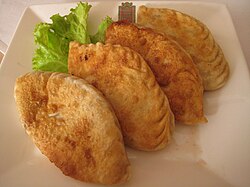
Khuushuur (Mongolian: хуушууp [xʊ́ːʃʊr]; Russian: чебуре́к, tr. cheburek, IPA: [t͡ɕɪbʊˈrʲek]; Chinese: 火烧儿; pinyin: huǒshāor) is a meat pastry that is popular in Mongolia, which is similar to recipes in Russian and other cuisines like Chebureki or Jiucai hezi. It is a circle of wheat flour dough folded in half around a filling of minced or ground beef, mutton, or camel, and ground up or deep fried. The seasoning of the meat is with onion and salt (and sometimes garlic) and once served, Khuushuur can be eaten as is or accompanied by ketchup or Maggi sauce. Aside from the traditional meat-filled version, there are alternative preparations of Khuushuur. Some variations replace the meat filling with carrots, cabbage (although less popular), or mashed potatoes. These vegetable versions can retain a distinctive taste of mutton due to the use of cooking oil.[1] In a restaurant it is served four to an order with a lettuce leaf and gherkins on the side, or sometimes carrot salad in more high-end establishments.[1]
 | |
| Type | Dumpling |
|---|---|
| Place of origin | Mongolia |
| Main ingredients | Dough, meat (beef or mutton), onions or garlic, salt |
| |
See also edit
References edit
External links edit
Media related to Khuushuur at Wikimedia Commons
- Recipe
- Recipe Archived 2018-10-22 at the Wayback Machine
- Recipe


